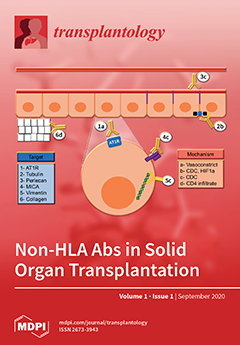Open AccessFeature PaperEditor’s ChoiceArticle
Timing of Nephrectomy and Renal Transplantation in Patients with Autosomal Dominant Polycystic Kidney Disease (ADPKD) in the Era of Living Kidney Donation
by
Rand T. S. Alkaissy, Alexander F. M. Schaapherder, Andrzej G. Baranski, J. Dubbeld, Andries E. Braat, Hwai-Ding Lam, W. N. Nijboer, J. Nieuwenhuizen, Dorottya K. de Vries, Volkert A. L. Huurman, Ian P. J. Alwayn and Koen E. A. van der Bogt
Cited by 2 | Viewed by 3578
Abstract
Autosomal dominant polycystic kidney disease (ADPKD) is one of the most common hereditary disorders. Once progressed to end-stage renal disease, kidney transplantation may be needed. Whether and when to perform a (bilateral) native nephrectomy in case of end-stage renal failure are issues under
[...] Read more.
Autosomal dominant polycystic kidney disease (ADPKD) is one of the most common hereditary disorders. Once progressed to end-stage renal disease, kidney transplantation may be needed. Whether and when to perform a (bilateral) native nephrectomy in case of end-stage renal failure are issues under debate. At our institution, with a growing number of living kidney donations, the general trend is to perform a native nephrectomy prior to transplantation. Our aim was to compare the outcomes of this approach to a nephrectomy during or after transplantation and to compare our findings to results reported in the literature. Data were prospectively collected from all ADPKD patients undergoing native nephrectomy and kidney transplantation at the Leiden University Medical Center between 2000–2017. A literature search was performed in the PubMed and Scopus databases. The clinical results were retrospectively reviewed and were stratified according to the timing of the nephrectomy. From the literature review, the most practiced approach was a combined unilateral nephrectomy and kidney transplantation. However, in our series, the favored approach was to perform a scheduled bilateral nephrectomy prior to kidney transplantation. A total of 114 patients underwent a native nephrectomy prior to (group 1,
n = 85), during (group 2,
n = 5), or after (group 3,
n = 24) kidney transplantation. There were no statistically significant differences in postoperative morbidity after nephrectomy nor differences in kidney transplant outcome. Bilateral nephrectomy prior to kidney transplantation is a safe, controlled approach carrying minimal complication and mortality rates and facilitating a subsequent transplant procedure without mechanical or hemodynamic limitations for the graft.
Full article




